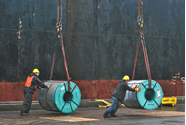Features
Tampa Steel: Analysts forecast lower sheet prices this year
Written by Laura Miller
January 30, 2024
With rising steelmaking capacity and flat demand, industry analysts are predicting lower prices for sheet products this year.
Speaking at the Tampa Steel Conference this week, Josh Spoores, principal analyst at CRU, said sheet prices are ‘rounding the top’ of this cycle. He anticipates prices to fall relatively quickly over the next quarter or two before beginning to level out.
He forecasted hot-rolled coil (HRC) prices to be around $805 per short ton this year.
The forecast from Wolfe Research’s Timna Tanners was similar: $930/st in Q1, $775/st in Q2, $750/st in Q3 and Q4, with an annual average of $801/st.
Alex Hacking, a metals and mining analyst at Citi, predicted an HRC range of $650-1,100/st for the year, with an average of $850/st.
All three analysts agreed that steel prices are unlikely to go back to the pre-Covid ‘normal’ of sheet prices in the $600s/st. “$850 is the new $650,” Hacking commented, while Spoores said a more normalized price now is $750-800/st.
Hacking noted two additional things supporting higher steel prices: cost inflation and the cost of cap-ex, which is now much higher than in 2018.
Spoores said 2024 will be a good year for companies to strategically position themselves for better-than-trend growth in 2025 and 2026.
The Great Scrap Squeeze
At the conference, Tanners introduced her new “Great Scrap Squeeze” thesis, which is a continuation of her ‘Sheet Storm’ thesis that’s been prevalent for a few years now.
She’s doubling down on that sheet storm and is now bracing for a scrap surge.
In 2024, there will be even more sheet supply coming to market, and demand for scrap is going to increase significantly, she said.
She cited new sheet capacity coming online – AM/NS Calvert, a full ramp-up at SDI’s Sinton mill, Algoma Steel’s new EAFs, U.S. Steel’s Big River 2 project, and Nucor’s new West Virginia mill – that will create an estimated 9 million tons of additional scrap demand.
“We think there will be a run on scrap,” Tanners said. “Scrap costs will go up. I don’t think they’ll be able to pass it through in an excess sheet supply environment.”
Another supply-side risk that could surprise the market is the potential for a restart at AHMSA, Tanners noted. Spoores commented that when the Mexican steelmaker closed in late 2022, its production was taken out of an already tight market. If it comes back, it will be coming back into a much looser market, he said. Tanners also noted that an AHMSA restart would bring a less disciplined player back to the market.

Laura Miller
Read more from Laura MillerLatest in Features

Final Thoughts
The Trump tariff drama continues.

US steel exports fall in February: Commerce
The volume of steel exported from the US declined in February, reversing January’s surge, according to the latest US Department of Commerce figures. This comes just two months after export levels had fallen to a two-year low.

Trump still against selling USS to Japanese firm: Report
Despite ordering a new review of Nippon Steel’s bid for U.S. Steel, President Trump said he is still against selling USS to a Japanese company, according to media reports.

Steel market chatter this week
SMU polled steel buyers on an array of topics this week, ranging from market prices, demand, and inventories to imports and evolving market events. We are sharing some of the comments we collected.

Final Thoughts
Let’s just say the impact of the latest tariffs on the domestic steel market is uncertain at best.
